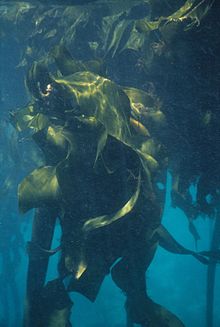Ecklonia maxima
Appearance
| Ecklonia maxima | |
|---|---|

| |
| Ecklonia maxima | |
| Scientific classification | |
| (unranked): | |
| Division: | |
| Class: | |
| Order: | |
| Family: | |
| Genus: | |
| Species: | E. maxima
|
| Binomial name | |
| Ecklonia maxima | |
Ecklonia maxima, sea bamboo, is a species of kelp native to the southern oceans. It is most typically found along the southern Atlantic coast of Africa, from the very south of South Africa north to Namibia. In these areas the species dominates the shallow, (up to 8 m) temperate-water kelp forests offshore.[1][2]
From the holdfast attached to a rock or the large holdfast of another kelp, a single long stipe rises to the surface waters, where a single large pneumatocyst holds a tangle of blades at the surface.[2]
The species is of economic importance: it is harvested for both an agricultural supplement and as food for abalone raised on farms.[3][4]
References
- ^ Anderson, R. J.; P. Carrick; G. J. Levitt; A. Share (1997). "Holdfasts of adult kelp Ecklonia maxima provide refuges from grazing for recruitment of juvenile kelps". Marine Ecology Progress Series. 159. Germany: Inter-Research: 265–273. doi:10.3354/meps159265.
{{cite journal}}:|access-date=requires|url=(help) - ^ a b Mann, Kenneth H. (2000). Ecology of Coastal Waters: With Implications for Management. Wiley-Blackwell. p. 406. ISBN 978-0-86542-550-7.
- ^ Robertson-Andersson, D. V.; D. Leitao; J. J. Bolton; R. J. Anderson; A. Njobeni; K. Ruck (2006). "Can kelp extract (KELPAK) be useful in seaweed mariculture?". Journal of Applied Phycology. 18 (3–5). Springer: 315–321. doi:10.1007/s10811-006-9030-1.
{{cite journal}}:|access-date=requires|url=(help) - ^ Anderson, R. J.; M. D. Rothman; A. Share; H. Drummond (2006). "Harvesting of the kelp Ecklonia maxima in South Africa affects its three obligate, red algal epiphytes". Journal of Applied Phycology. 18 (3–5). Springer: 343–349. doi:10.1007/s10811-006-9037-7.
{{cite journal}}:|access-date=requires|url=(help)
Wikimedia Commons has media related to Ecklonia maxima.
